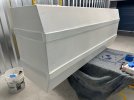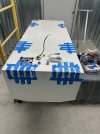Hi, thought I would run an idea by the forum for comment. I need new fuel tanks for my 228. The main tank is shot and the aux is running on borrowed time. The original drawings show .125 is to be used for the 92 gallon main tank, and .09 is to be used for the aux. My understanding is that when pinholes appear, they will be bottom and/or top of the tank. Is that a true statement? if so, does it make sense to specify using a thicker material like 3/16ths on the top and bottom skins only? There would be no point of using 3/16 for the tank sides and baffling because they wont develop pinholes and that will save tank build costs.
You are using an out of date browser. It may not display this or other websites correctly.
You should upgrade or use an alternative browser.
You should upgrade or use an alternative browser.
Fuel tank idea - comments?
- Thread starter Chinookie
- Start date
The reason for the pin holes is corrosion from galvanic activity that is generated when the aluminum comes in contact with another conductive material in the presence of moisture (mainly sea water) as an electrolyte.
Often the tanks sit on structural supports, bulkheads or stringers in addition to whatever is used to hold the tank in place like topside straps, or tank brackets. Moisture often gets trapped between the supports and the tank surface. Depending on what materials were used an mounting surfaces and/or insulators, corrosion can occur.
In summary, the methods and materials used to mount the tank and protect the tank coffin from trapping moisture are more important that the tank thickness, Yes, thicker material will take longer for the corrosion to go through the tank wall but it won't stop it.
Often the tanks sit on structural supports, bulkheads or stringers in addition to whatever is used to hold the tank in place like topside straps, or tank brackets. Moisture often gets trapped between the supports and the tank surface. Depending on what materials were used an mounting surfaces and/or insulators, corrosion can occur.
In summary, the methods and materials used to mount the tank and protect the tank coffin from trapping moisture are more important that the tank thickness, Yes, thicker material will take longer for the corrosion to go through the tank wall but it won't stop it.
DennisG01
GreatGrady Captain
- Joined
- Sep 1, 2013
- Messages
- 7,818
- Reaction score
- 1,543
- Points
- 113
- Location
- Allentown, PA & Friendship, ME
- Model
- Offshore
To add onto what Seasick said... another common cause for corrosion in this area is when water is allowed to sit on the aluminum. Or, more specifically, when aluminum does not have contact with the air. When Al has good oxygen, it will self protect itself.
So, the solution, as noted above, is to build a mouse trap than Grady did. You can epoxy coat the tank... you can ensure the installation doesn't allow any gaps/cracks where water will sit or where the AL won't have air movement around it.
So, the solution, as noted above, is to build a mouse trap than Grady did. You can epoxy coat the tank... you can ensure the installation doesn't allow any gaps/cracks where water will sit or where the AL won't have air movement around it.
Hookup1
GreatGrady Captain
- Joined
- Oct 16, 2007
- Messages
- 3,575
- Reaction score
- 1,011
- Points
- 113
- Age
- 71
- Location
- Cape May, NJ
- Model
- Islander
Take a look at my thread below. My advise is to have quality tanks made at a certified tank builder. SP Tanks is too far away from you. I'm sure there are West Coast builders.
Use 0.125 aluminum. Have the tank epoxy primed. Install nitril strips with 3M4000 to insulate the tank. Corrosion will occur where water is trapped against the tank. Install new deck ports with 3m4000, clear grease on o-rings and consider caulking them with silicone. This will keep water off the top of the tank. Make sure you deck is solid (not full of water) and screws are properly caulked.
Use 0.125 aluminum. Have the tank epoxy primed. Install nitril strips with 3M4000 to insulate the tank. Corrosion will occur where water is trapped against the tank. Install new deck ports with 3m4000, clear grease on o-rings and consider caulking them with silicone. This will keep water off the top of the tank. Make sure you deck is solid (not full of water) and screws are properly caulked.
Decided that this is the year to replace my 25 yo fuel tanks. No leaks. I plan to keep the boat. I'll document the process here.
Pulled the hatch. This hatch was rebuilt a few years ago with Coosa board. Looks good and feels solid. Hatch was set with 3M 4000 - kept everything sealed. Some difficulty cutting with blade to get it up. Not sure what it will go down with. Deck ports were caulked in from the underside as well. Kept the tanks dry.
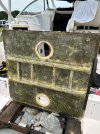
I also put plastic over the fill, sending unit and pickup. This deflects any water away from the busy area of the tank.
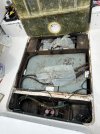 ...
...
Pulled the hatch. This hatch was rebuilt a few years ago with Coosa board. Looks good and feels solid. Hatch was set with 3M 4000 - kept everything sealed. Some difficulty cutting with blade to get it up. Not sure what it will go down with. Deck ports were caulked in from the underside as well. Kept the tanks dry.

I also put plastic over the fill, sending unit and pickup. This deflects any water away from the busy area of the tank.
 ...
...- Hookup1
- Replies: 70
- Forum: Tips, Modifications and Electronics
Sardinia306Canyon
GreatGrady Captain
- Joined
- Oct 11, 2023
- Messages
- 999
- Reaction score
- 220
- Points
- 43
- Age
- 61
- Location
- Island of Sardinia
- Model
- Canyon 306
All good pints above, nothing to add.
I wrote it already in other treads, if the top of the fuel tank would be slightly curved with a flat spot for fuel sender plate then the water dropping from the pie plate above to sender unit would still drip there, but not poodle there as it would run away to the sides and away from fueltank top.
I am still thinking about how to make a "gutter" below pie plate to deviate the water.
However coal tar the tank seems the best way to preserve a aluminum fuel tank for longest time, even if no coating at all would be best if fuel tank would be 100% dry.
Chris
I wrote it already in other treads, if the top of the fuel tank would be slightly curved with a flat spot for fuel sender plate then the water dropping from the pie plate above to sender unit would still drip there, but not poodle there as it would run away to the sides and away from fueltank top.
I am still thinking about how to make a "gutter" below pie plate to deviate the water.
However coal tar the tank seems the best way to preserve a aluminum fuel tank for longest time, even if no coating at all would be best if fuel tank would be 100% dry.
Chris
For my tank in my 209, I took a bit from the aviation field. I used zinc chromate from a Pilot supply house, then epoxy coated the entire tank. I even added some glass to the edges for extra protection. Then I epoxied plastic strips to the bottom and ends of the tank for air to circulate around it. It might be overkill, but I don't ever want to pull the center console again. Ha Ha.
Attachments
Hookup1
GreatGrady Captain
- Joined
- Oct 16, 2007
- Messages
- 3,575
- Reaction score
- 1,011
- Points
- 113
- Age
- 71
- Location
- Cape May, NJ
- Model
- Islander
Painting fuel tanks even with epoxy doesn't always protect the tank. Some tank builders will tell you not to paint them at all. The reason is the paint doesn't stick well to aluminum. Zinc chromate is a toxic paint that does an excellent job of preparing the tank. For my tower that was sandblasted I used AwlGrip etch primer before painting it (working great). My tanks were straight epoxy painted by the tank builder (looks pretty but latent defect).
Key thing to consider is making sure the plastic strips stay attached to the tanks. If there is an air gap it invited corrosion. I won't happen immediately even if not perfect. Make sure that nothing contacts the tank on sides or bottom. Tank should be "insulated" and float in the fuel coffin. I usdsed nitric strips and 3M4000.
You should be fine though.
Key thing to consider is making sure the plastic strips stay attached to the tanks. If there is an air gap it invited corrosion. I won't happen immediately even if not perfect. Make sure that nothing contacts the tank on sides or bottom. Tank should be "insulated" and float in the fuel coffin. I usdsed nitric strips and 3M4000.
You should be fine though.
Question for the group: does fuel tank corrosion always happen from the outside-in? in other words, could there be also corrosion on the inside of the tank due to moisture condensation (moisture intake related to use of E10 gas versus ethanol-free gas). And related question, does it make sense to use only ethanol-free gas to reduce moisture condensation on the inside of the tank?
Hookup1
GreatGrady Captain
- Joined
- Oct 16, 2007
- Messages
- 3,575
- Reaction score
- 1,011
- Points
- 113
- Age
- 71
- Location
- Cape May, NJ
- Model
- Islander
Fuel tank's are a replaceable maintenance item. You can't make them last forever. 25 years is a reasonable goal. At that point you just don't know.
It always pays to use ethanol free gasoline. It's far better for your engines. The tanks will take care of themselfs.
It always pays to use ethanol free gasoline. It's far better for your engines. The tanks will take care of themselfs.
Last edited:
Sardinia306Canyon
GreatGrady Captain
- Joined
- Oct 11, 2023
- Messages
- 999
- Reaction score
- 220
- Points
- 43
- Age
- 61
- Location
- Island of Sardinia
- Model
- Canyon 306
Question for the group: does fuel tank corrosion always happen from the outside-in? in other words, could there be also corrosion on the inside of the tank due to moisture condensation (moisture intake related to use of E10 gas versus ethanol-free gas). And related question, does it make sense to use only ethanol-free gas to reduce moisture condensation on the inside of the tank?
The stainless steel tanks we use/d here in Italy do that for sure, i replaced many because of that and the pin holes where always at the lower bend of the the rear wall where the water drops accumulate.
Not sure if aluminum tanks do the same, my BW 23 Outrage tank developed pin holes from the outside as due the outboards weight rear end was touching the bilge water.
This tank was hanging on brackets an was perfectly fine, and after about 20 years outside on the junk pile it still looks fine, just dull for surface oxidation.
Best would be to not cover a aluminum tank with anything on it, but tank would need to hang on brackets and not touching bilge water.
Yes, if available non-ethanol gas would be better,
but water in fuel comes often from leaks and/or condensation inside the tanks wall due hight temperature differences between day and night.
Chris
49pan
GreatGrady Captain
- Joined
- May 22, 2024
- Messages
- 59
- Reaction score
- 1
- Points
- 8
- Age
- 70
- Location
- West Chester pa
- Model
- Seafarer
I made my tank out of 5052-H32 .187 thick. Pressure tested to 4 psi. I did not paint it at all . I read it really doesn’t protect it that much and some manufacturers are not doing it at all. Per Grady it should me mounted on neoprene rubber stripes. I know it will last 25 years and that’s longer than I’ll be around
Sardinia306Canyon
GreatGrady Captain
- Joined
- Oct 11, 2023
- Messages
- 999
- Reaction score
- 220
- Points
- 43
- Age
- 61
- Location
- Island of Sardinia
- Model
- Canyon 306
Yes, you are correct, non treated aluminum will oxidize and protect itself as long it's not submerged or water is pooling above as in most cases where the fuel tank senders are.
Worst for raw aluminum is constant humidity what will pit aluminum and for this reason no foaming in and PVC strips instead of neoprene what is spongy, and the strips have to be perfectly glued on so that no humidity can collect between strip and tank.
The main problem of painted aluminum is same as on any painted aluminum structure, sooner or later humidity creep between paint and aluminum and start oxidation creating aluminum oxide powder what remain always humid and accelerate the process of bubblin/flaking off the paint. Not a aesthetic issue on a fuel tank, but a problem for faster pitting.
When i have to replace my fuel tanks i am still not sure if i wan't them coal tar coated, or bare aluminum, i think i will decide when i have them out and see in what shape they are below to decide if cola tar epoxy is needed or not.
Below a photo of my 1998 BW 23 Outrage's fuel tank we pulled around 2008 and from then shipyard owner left it outside exposed to the elements. The fuel tank developped pinholes on the bottom where tank was touching bilge water due a different boat level after i installed considerable more heavy twin F150's and she became stern heavy.
My Outrage was a lemon, but one thing BW did theoretically well is that the fuel tank is hanging on the brackets, but it was like only 100 gallons. The hanging tank avoid strips where other tanks rest, but BW made the tank too deep so he touched bilge water and corroded :-(
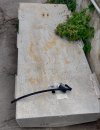
Worst for raw aluminum is constant humidity what will pit aluminum and for this reason no foaming in and PVC strips instead of neoprene what is spongy, and the strips have to be perfectly glued on so that no humidity can collect between strip and tank.
The main problem of painted aluminum is same as on any painted aluminum structure, sooner or later humidity creep between paint and aluminum and start oxidation creating aluminum oxide powder what remain always humid and accelerate the process of bubblin/flaking off the paint. Not a aesthetic issue on a fuel tank, but a problem for faster pitting.
When i have to replace my fuel tanks i am still not sure if i wan't them coal tar coated, or bare aluminum, i think i will decide when i have them out and see in what shape they are below to decide if cola tar epoxy is needed or not.
Below a photo of my 1998 BW 23 Outrage's fuel tank we pulled around 2008 and from then shipyard owner left it outside exposed to the elements. The fuel tank developped pinholes on the bottom where tank was touching bilge water due a different boat level after i installed considerable more heavy twin F150's and she became stern heavy.
My Outrage was a lemon, but one thing BW did theoretically well is that the fuel tank is hanging on the brackets, but it was like only 100 gallons. The hanging tank avoid strips where other tanks rest, but BW made the tank too deep so he touched bilge water and corroded :-(

49pan
GreatGrady Captain
- Joined
- May 22, 2024
- Messages
- 59
- Reaction score
- 1
- Points
- 8
- Age
- 70
- Location
- West Chester pa
- Model
- Seafarer
Nifty you are thinking of neoprene as in a dive suit you are correct. The neoprene I’m talking about can be purchased in rolls. .312 X 2.0 . It is hard rubber which is difficult to cut with a utility knife. Then glue it down with 4200
Hookup1
GreatGrady Captain
- Joined
- Oct 16, 2007
- Messages
- 3,575
- Reaction score
- 1,011
- Points
- 113
- Age
- 71
- Location
- Cape May, NJ
- Model
- Islander
Last edited:
That is the best method. The trick with strips is to not run them past the edge of the tank. Stop an inch or two before.Not sure about how much protection painting but you but I did mine anyway.
I used white nitrile strips and 3M4000 from SP Tanks in Clermont, NJ
You want to avoid and areas where water can pool/sit.
Sardinia306Canyon
GreatGrady Captain
- Joined
- Oct 11, 2023
- Messages
- 999
- Reaction score
- 220
- Points
- 43
- Age
- 61
- Location
- Island of Sardinia
- Model
- Canyon 306
Yes, as scuba instructor and RIB owner neoprene is mentally associated with a kind of foam.Nifty you are thinking of neoprene as in a dive suit you are correct. The neoprene I’m talking about can be purchased in rolls. .312 X 2.0 . It is hard rubber which is difficult to cut with a utility knife. Then glue it down with 4200
If the Neoprene you are talking of is not foam and solid material then it should be ok, however most suggested is PVC strips.
Yes using PU adhesive as 3M or Sika is correct, important tis that here are no leaks where humidity can creep in between.
Chris
Hookup1
GreatGrady Captain
- Joined
- Oct 16, 2007
- Messages
- 3,575
- Reaction score
- 1,011
- Points
- 113
- Age
- 71
- Location
- Cape May, NJ
- Model
- Islander
Don't forget to insulate front, back and mounting pads.
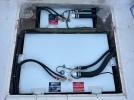
AI Overview
For insulating aluminum fuel tanks,
nitrile is superior to neoprene because of its better resistance to fuels and oils. Neoprene offers only moderate fuel resistance and will degrade with prolonged exposure to petroleum products.
However, neither material should be used to completely enclose an aluminum tank. Trapping moisture against the aluminum is a primary cause of corrosion. The insulation should be used as pads or strips to prevent metal-on-metal contact and damp vibration, while allowing for airflow.

AI Overview
For insulating aluminum fuel tanks,
nitrile is superior to neoprene because of its better resistance to fuels and oils. Neoprene offers only moderate fuel resistance and will degrade with prolonged exposure to petroleum products.
However, neither material should be used to completely enclose an aluminum tank. Trapping moisture against the aluminum is a primary cause of corrosion. The insulation should be used as pads or strips to prevent metal-on-metal contact and damp vibration, while allowing for airflow.
Last edited:


